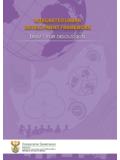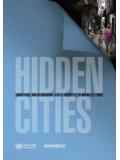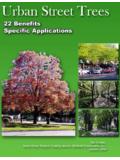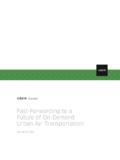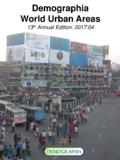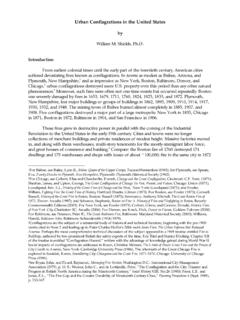Transcription of Urban Land Use Planning 6.2 - CharacterTowns.org
1 A wck Planning project Book Review May 2015 Urban land Use Planning Edward J. Kaiser, David J. Godschalk and F. Stuart Chapin Jr, Summary Fourth Edition, University of Illinois Press, Urbana, 1995. YouTube Published Reviews Summary Urban land Use Planning , the book, has evolved and grown as a body of thought for over a half century. The Fourth Edition of Urban land Use Planning presents the classic approaches to Planning theory and practice. The Fourth Edition is chock full of tables and charts and checklists that provide the framework for comprehensive Planning to detailed studies.
2 The Fourth Edition cites the famous Rational Planning Model: Figure 2 1. The Rational Planning Model: A Logical Progress from Goals Setting to Implementation and Back [p38] is a great example of the depth and simplicity of thought expressed in Dr. Chapin's work. The Fourth Edition has three authors: Messrs. Kaiser, Godschalk F. Stuart Chapin, Jr. and Chapin. The Third Edition, 1979, was written by Professors Chapin and Kaiser. The First Edition [1957] and the Second Edition F. Stuart Chapin, Jr., professor emeritus at the University of [1965] were solo efforts.
3 This history is recited for two reasons: North Carolina, taught from the first is to celebrate the longevity of the book and its basic ideas. 1949 to 1978. He applied social science methods to the study It has served as a guide for Planning practitioners and students for of Urban growth, systematizing over 50 years. Second, is the collaboration of the authors; a great the study of activity patterns, and emphasizing citizen object lesson in teamwork over a sustained period of time. participation in the Planning process. Professor Chapin was In addition to being a guide for processes, Urban land Use Planning designated a National Planning offers standards to consider when designing specific developments.
4 Pioneer in 1993. As examples, standards are provided for: Shopping Center Types and Characteristics [Table 13 2, p322], Density Standards for Employment in the land Use Plan by Type of Employment, Employment Center, and Location (employees per acre, gross densities) [Table 13 5, p331] and Suggested Standards for Siting Schools [Table 15 2, p387]. In today's GIS world, these standards can be created based on real time, local information. The point is not about the standard, but that standards can be established and should be used. Finally, Chapter 16, Development Management Planning [p 398] answers the question once the plan is done, what's next?
5 The authors provide a useful answer to this question. Urban land Use Planning by Messrs. Kaiser, Godschalk and Chapin 1 a wck Planning project Book Review May 2015 The Fifth Edition, published in 2006, is authored by Philip R. Berke and David R. Godschalk. It offers a Planning guide of continuing value by updating the work that was then nearly 30 years old. As discussed in the Amazon Review below, many innovations have added to the richness of the community Planning profession and process, such as sustainability theory, the new urbanism, the internet and globalization, to mention a few.
6 The Fifth Edition is the place to start when venturing into this subject, but the innocence of thought in the previous versions is worth a look. YouTube The following in not really a YouTube of the book, but a video of Dr. Chapin recalling the early days of the department, , The University of North Carolina Planning Department: F. Stuart Chapin, Jr., from DCRP 5 years ago [say 2010] From an original concern for applications of social science to regional development needs, coupled with a traditional basis in physical Planning prevalent in the 1940's and 1950's, the Department broadened the scope of its curriculum and its faculty in the following decades.
7 Urban and community Planning were included almost from the start, and land use Planning became the basic approach to physical Planning . Social Planning , housing, and environmental Planning were added in the 1960's. Economic development and community development were added in the 1970's. The Department added Planning in developing countries, real estate development, and public policy analysis in the 1980's. The History, Design and Preservation of the Built Environment is the most recent specialization addition. The Department has also increased its dual degree and certificate programs.
8 With populations growing, environmental concerns increasing, and laws becoming more complex, DCRP has teamed with other departments to create dual degree programs that meet the increasing demands facing Urban America. Current dual degree programs include: Business, Landscape Architecture, Law, Public Administration and Public Health. The concept of sustainable development as a goal of Planning remains central to the Department's mission. Whether the objectives are improved physical, social, economic, or environmental conditions, or more efficient and equitable policies, programs and environments, Planning is a way of effectively marshalling resources to public development objectives.
9 The professional planner combines an understanding of Urban and regional theory grounded in a spatial context and a grasp of Planning and management methods to guide development in the public interest. The history of the Department is also revealed by several founding faculty members. John A. Parker was the founder and head of the Department for its first 28 years, through 1974 and remained active in alumni affairs and other departmental functions for the subsequent 25 years. Jim Webb, designer, practitioner and contributor to the original plan for the Research Triangle Park, was the first faculty member hired by Parker.
10 F. Stuart Chapin, Jr., the second faculty member hired by Parker, became the Urban land Use Planning by Messrs. Kaiser, Godschalk and Chapin 2 a wck Planning project Book Review May 2015 model social science scholar and wrote the seminal text on Urban land use Planning . Maynard Hufschmidt came from the Harvard water resources Planning program in the 1960's, to help build the environmental and policy analysis areas. Shirley Weiss became a leading scholar in central city revitalization and large scale development Planning . Edward Kaiser spent his entire 38 year career here carrying on Chapin's work and contributing significantly to the field of development management.
